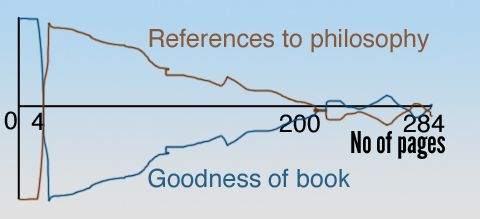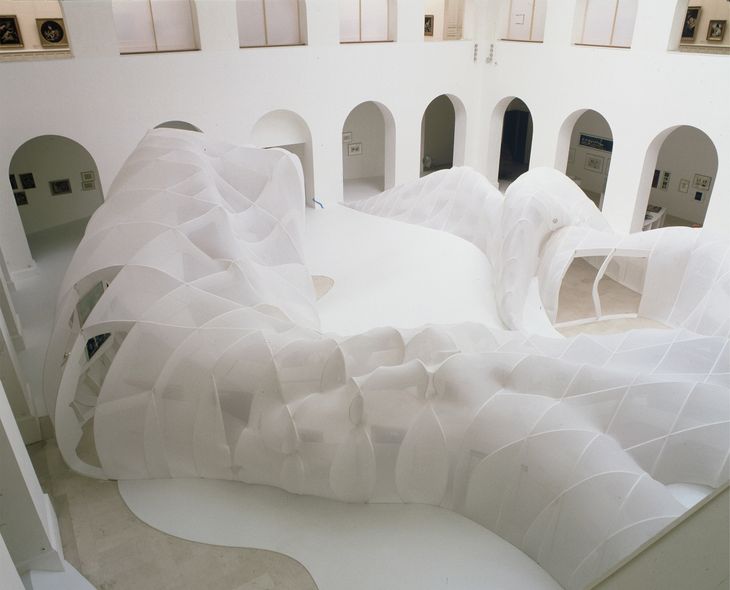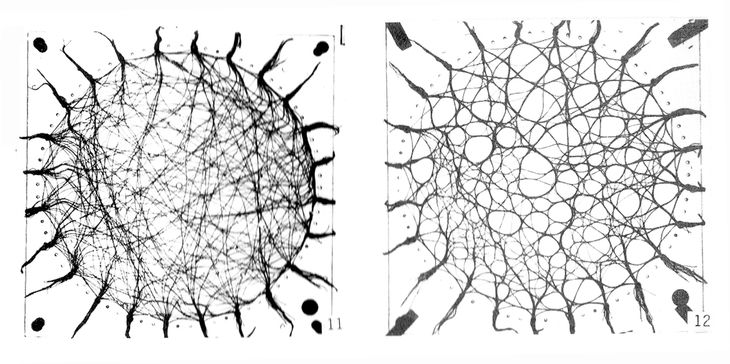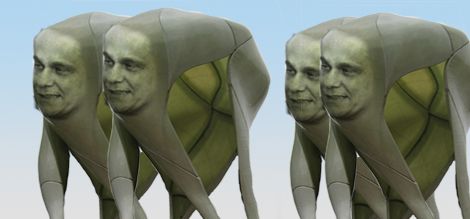Areader emailed me last month to ask, amongst other things, why I had not written about Lars Spuybroek. A fair question. The honest and slightly embarrassing answer is that I never made it past the pictures in the NOX books, dismissing the whole thing as blobitecture. Strange how you can arrive as such an entrenched position with so little provocation, and ironic because Spuybroek says the word 'blob' gives him nightmares. So I added Spuybroek to my Christmas reading list [1] and choose The Architecture of Continuity to get started on because it had the least number of pictures to distract me.
Two pages in and I almost named my first born Lars, four pages in I almost threw the book down in disgust, and things didn't really pick up from there until about page 200, from where the book meandered between insightful and irrelevant (see graph below).

From this graph it is clear that all of the good parts are where Spuybroek is not talking about philosophy, but unfortunately Spuybroek loves nothing more than talking about philosophy. Most of the time it is clever, although irrelevant, intellectualism. For example when talking of a hanging chain model (pg 20), Spuybroek writes:
I call this the 'Semperian reversal': the reversal of the order of the four elements. Instead of starting with earth and a wooden frame to support the weaker textile fibers, I reason the other way around: weak threads move, find each other, and lock into each other, building structure and rigidity. So instead of adding the soft to the rigid, as Semper did, we see a transformation of soft into rigid.
Now hanging chains are wondrous things, and there are many things you can write about them. You could talk about them in terms of mathematics, in terms of the design process, in terms of architectural history, even in terms of the demise of the flying buttress, but fairly low down on the list would be talking about them in terms of the order of Semper's four elements of architecture. That is not to say Spuybroek is wrong, but it is a powerful insight applied to a insignificant topic.
This critique is applicable to almost any passage in the book, which often struggles to find purpose. One of the causes may be that the book is a collection of essays, presented in chronological order but not dated (except in some endnotes tucked into the final pages). It is not until you reach these endnotes that you find out the early fragments of the book are almost 15 years old (accounting for their philosophical bent), and the entire text spans 10 years. A lot has changed in digital architecture in this time, although Spuybroek does not dwell on it.
When Spuybroek does get to the point he seems to hold a similar position to Schumacher, arguing that architecture has lost its way, and that there should be a unification of style brought about by digital technology. Schumaker and Spuybroek diverge in their definitions of this style. For Schumacher this style is derived from the qualities of the digital: gradients of difference, independence and a softness of form. Spuybroek however returns to the Gothic, and argues for an architecture of continuity. Much of the book is spent either explaining what continuity is or explaining why Spuybroek is Gothic. It is an eloquent and well researched argument but what Spuybroek calls himself and what he calls his style, is not as important as arguing why continuity is desirable or arguing why the digital enables continuity (especially when the Gothic could do it pre-digital) . No doubt he has an answer, but it is not in this book. In this sense I think Schumacher takes a stronger position. Leaving aside any arguments about style, at least Schumacher's Parametrisism is based in part on the nature of digital tools, whereas Spuybroek is far more eager to discuss philosophy than the digital.

wetGRID NOX architects
These jumps in logic carry into his projects. Taking the wetGRID project as an example, Spuybroek explains how Frei Otto's wool-thread machine optimises paths through a space - which it does (See image below). He then uses the method to generate paths between two colonnades and wraps the paths with a skin to house art. Somewhere in there Spuybroek has made the assumption that optimum paths through a gallery would be desirable, and that the wool-thread machine makes optimum paths in this situation (it doesn't because it can not guarantee a route that does not involve retracing where you have been). So we are left with a beautiful structure that due to some hidden jumps in logic is devoid of the properties Spuybroek went to great lengths explaining. I am afraid this could be seen as an analogy for the entire book. I think it is dangerous to have students reading authors like Spuybroek, imitating his projects and ending up with a pastiche of well known algorithms. If you want to learn about philosophy and digital architecture read Kostas Terzidis' An Algorithmic Architecture, if you want to hear about the demise of architecture read Neil Leach's The Anasthetics of Architecture, and if you have a Christmas to kill, and can put up with all of Spuybroek's meandering, then on about page 201 you will find some good stuff in The Architecture of Continuity.
Lars Spuybroek / NOX Architects website

Wool thread model - From Schumacher - Parametricism - AD 2009
- I also read Bill Bryson's At Home, a book on the history of architecture. It does not quite fit into this blog but I would say it is one of the best architecture books I have ever read and easily the most enjoyable. Find it and read it.

Ben Regnier
Ha! You are right about Terzidis' book, although the first chapter gave me almost the same reaction with all of the etymology. I'm pulling it back out for a reread right now.
Daniel
Yea I think the etymology in Algorithmic Architecture is a bit too heavy, but to Terzidis' credit, he does directly define the implications for design that arise from these words and ties this back to his central message. Then again, I read Terzidis' first so perhaps I have just brought into his world view.
astha
lars < fred